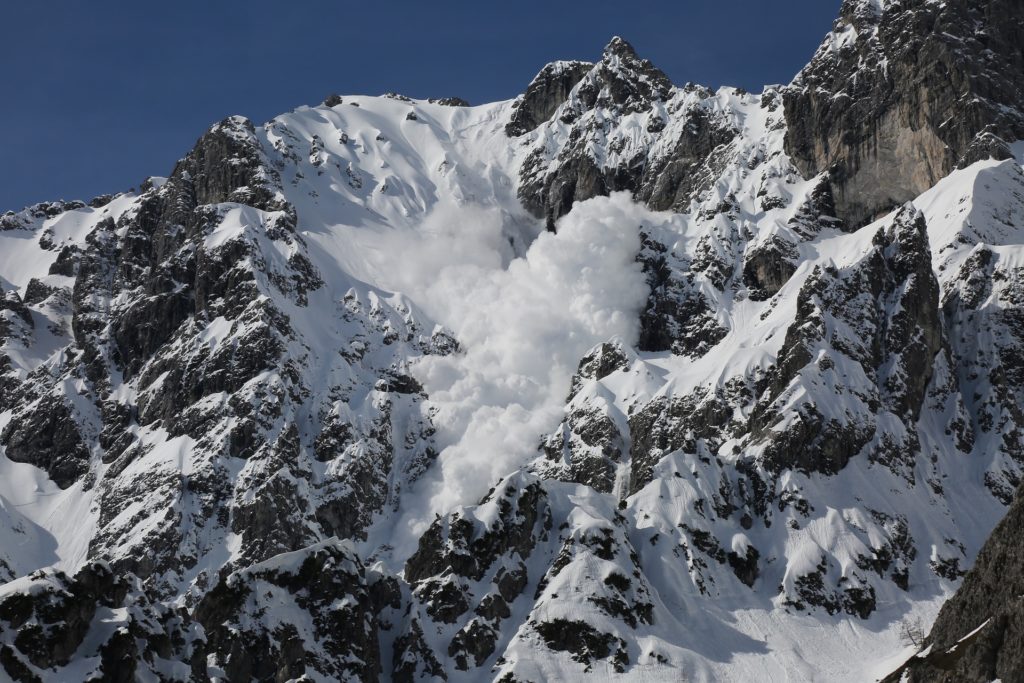What causes an avalanche?
by Scott Dutfield · 16/05/2020
With 1 million avalanches occurring each year, what creates these snowy landslides, and how can we predict them?

Mountaintops are like a continuous dumping ground for the clouds, with some accumulating metres of snow every day during winter seasons. Snowy peaks usually remain calm in blissful winter wonderland scenes, but the sudden arrival of icy clouds can dramatically transform them.
Looking at a snow-covered mountain, it is difficult to determine the composition of the icy layers below and the strength at which snow clings to the mountainside. Just one wrong foot placement, a day of heavy snowfall or even a loud sound can send a huge portion of a mountain’s white coating racing down towards the bottom.
This freefall of snow, ice and sometimes rocks down a mountainside is called an avalanche, and it is the cause of over 150 deaths around the world each year. Avalanches can reach speeds of 130 kilometres per hour in the space of just five seconds, giving little warning to anyone in its path. A combination of three factors determine how susceptible a mountainside is to an avalanche. This is known as the ‘avalanche triangle’, consisting of terrain, weather and snowpack. An incline of between 30 and 45 degrees will accumulate enough snow for avalanche conditions. Weather is important to factor in too, as wind, temperature and snowfall all contribute to the risk of an avalanche. The final side of the triangle highlights the need for understanding the snowpack and the behaviour of the different layers of snow. Digging into the snow and observing layers can reveal a lot about the history of the snowfall, and can be key in determining avalanche-prone areas.
Not all avalanches hurtle down the slopes at equal speeds, as avalanche properties can vary.
Damp snow can move fluidly, almost like icy cement, while other avalanches proceed in a rough tumble, projecting clumps ahead of them in a disorganised descent. One thing all avalanches have in common is the ability to engulf everything in their path. If not for the impact on human life, avalanches would be a breathtaking display of gravity’s destruction.
Mountain-dwellers such as skiers and mountain climbers are inevitably at the highest risk, and their movements are often the cause of an avalanche. Recently, headlines have shown how even those who know the mountains better than anyone can be caught up in an avalanche tragedy. In April 2019, three professional climbers lost their lives as they were swept down the mountain in Canada’s Banff National Park. The two Austrian climbers, David Lama and Hansjörg Auer, and one American, Jess Roskelley, were some of the world’s most accomplished climbers.
In 90 per cent of avalanche incidents involving people, one of the victims is thought to have triggered the avalanche by being on the slope at the wrong time. But as snow can travel for kilometres around, villages and towns situated in the shadow of a mountain can also fall victim to the snow. Whole towns have been known to disappear beneath these deadly deposits.
The key to predicting incoming avalanches comes from analysing the layers below the surface snow, and understanding the snow’s placement on the mountainside. A high liquid-water content within the snow increases the chances of snow slippage, while more snow on a mountain’s slope increases the pressure at the deepest point, raising the risk of the snow breaking off and sliding. In theory there are crucial signs to look out for, but in practice nature includes so many variations and additional factors to consider that avalanches are as difficult to predict as the weather.
To track conditions around avalanche-prone areas, scientists closely follow weather predictions alongside data from previous avalanches. Studying the physics of avalanches, researchers found that a slight drop in temperature can turn a slow avalanche into a deadly ‘dry’ one. Depending on how high-risk an avalanche is thought to be through mountain analysis, explosives are sometimes used in areas such as ski resorts to force avalanches to take place prematurely, when the lower volume of snow will create less danger. Additionally, dams are built to reduce the destruction of these premeditated avalanches.
Although scientists can attempt to predict the likelihood of an avalanche, it is impossible to keep track of conditions everywhere in the world. With 12 per cent of the Earth’s surface permanently covered in snow and ice, and with this percentage increasing during winter seasons, the surprise factor and instant danger created by a snow slip makes these almighty and terrifying spectacles as dangerous a phenomena as ever.
This article was originally published in How It Works issue 132, written by Ailsa Harvey
For more science and technology articles, pick up the latest copy of How It Works from all good retailers or from our website now. If you have a tablet or smartphone, you can also download the digital version onto your iOS or Android device. To make sure you never miss an issue of How It Works magazine, subscribe today!






